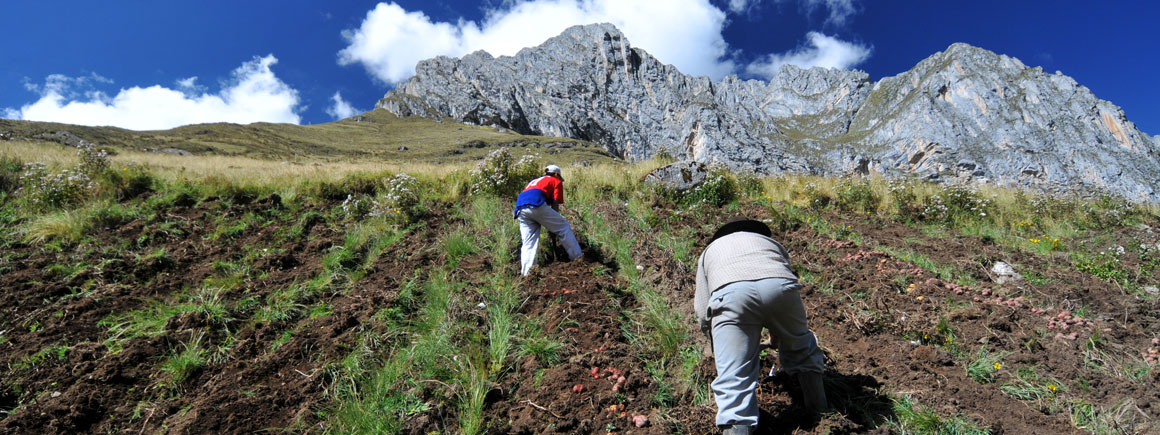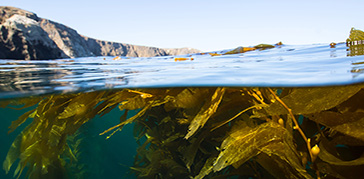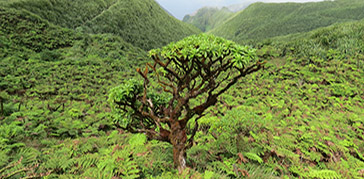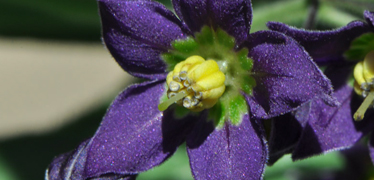Museum team
- Dr Sandy Knapp
- Dr Diana Percy
- Dr Erica McAlister
- Dr Daniel Whitmore
- Mindy Syfert

Hunting for crops in Peru
Museum scientists are seeking out wild relatives of food plants native to Peru to help breeders prepare stronger crops for the future.
Dr Sandy Knapp and a team of botanists, entomologists and data specialists from the Museum are seeking out and mapping the distribution of wild species related to tomatoes and potatoes.
This data allows plant breeders to find characteristics in wild plants that could help our crop species survive environmental changes and new pest epidemics.
But crossing plant species to breed varieties with desirable characteristics, such as a greater yield or better drought resistance, takes time.
Human population is predicted to reach 10 billion over the next 50 years, which means food supply has to rise dramatically. However, crop production is often hampered by changing climate, land degradation and water shortages. Understanding which wild relatives of commercial tomatoes hold key traits for future crops could help mitigate the challenges we face in food production.
Crops have been domesticated using traditional breeding techniques. Plants with desirable characteristics were crossed, and the best results were kept for further breeding. This was based on the way the plants looked - a bigger, juicer tomato would be selected for breeding over a smaller, hairier variety.
However, modern genetics shows that this selection process leaves out a lot of desirable traits. ‘Tomato domestication drastically narrowed the genetic base of crop tomatoes,' says Museum botanist Dr Knapp.
While some traits, such as insect resistance, are often coded by a single gene that can be easily selected by traditional breeding, more complex traits like yield are often controlled by different sets of genes.
For example, one wild species of tomato has hairy, green fruits that look and taste nothing like our sweet-tasting red tomatoes. But when it was crossed with elite tomato varieties, the results were tomato plants that produced more fruit with higher soluble solids (sugars) content and improved colour, despite the wild species’ seemingly undesirable traits.
Cases like this highlight the importance of evaluating wild species of crops based on their genes, not just their physical characteristics. Many wild species are held in gene banks worldwide, where seeds are available for genetic sequencing and also to plant breeders.
However, we don’t know everything about the wild relatives of our common crops, and this is where Dr Knapp and her team step in. The experts are filling in the gaps between the wild species of crops we have in gene banks and what species exist in nature.
The team are gathering information on wild crop relatives in two ways. In Peru wild tomato and potato species are abundant and on their field trips the team are collecting new material from different areas of the country. They are also digitising specimens from museum herbaria (collections of preserved plant specimens) across the globe. Both of these methods can locate new species, but they also allow the team to collect data on what traits those species have, and to relate this to their environment.
As data is collected, patterns will emerge, says Dr Knapp:
‘There may be populations on the edges of species ranges which are adapting to environmental conditions that are quite extreme. These could be very useful for plant breeding in the future as we go into more extreme environments.’
It’s not just plants the team are interested in however - their work now involves looking at pests. Just as crops have wild relatives, so do common crop pests. Out in the field, if Dr Knapp and the botanists collect a plant, the entomologists will collect and examine all the insects living on that plant.
Certain insects may prefer a particular plant, giving an indication of which insects could become crop pests. Other insects may only prefer plants in certain valleys, suggesting that the environment plays a role in which plants insects feed on.
This information could help breed crops with the right traits to avoid pest epidemics, which are so devastating to food supplies. ‘We can predict how insects would react in different environmental change models, and see which might explode in population density or change their host plant,’ says Dr Knapp.
The team have a couple more trips to Peru planned and entomologists Dr Diana Percy and Dr Erica McAllister are busy analysing insect collections from previous field trips to provide more data for the project.
A team at the Museum are also digitising the pest wild relatives held in our collections and associating them with the botanical specimens already digitised. Hopefully their work and expertise will result in the vital predictions we need to ensure a safe future for our crops.
Knapp S, Vorontsova M S and Prohens J (2013) Wild relatives of the eggplant (Solanum melongena L.: Solanaceae): new understanding of species names in a complex group. PLoS ONE 8(2): e57039.
Särkinen T, Olmstead R G, Bohs L and Knapp S (2013) A phylogenetic framework for evolutionary study of the nightshades (Solanaceae): a dated 1000-tip tree. BMC Evolutionary Biology 13: 212.
Ovchinnikova A, Krilova E, Gavrilenko T, Smekalova T, Zhuk M, Knapp S and Spooner M (2011) Taxonomy of cultivated potatoes (Solanum section Petota: Solanaceae). Botanical Journal of the Linnean Society 165: 107-155.

We study the Earth's origins and environment, and the evolution of life.

Studying a wide variety of plants, including bryophytes, ferns and flowering plants.

Explore our collection of an estimated six million specimens from around the world